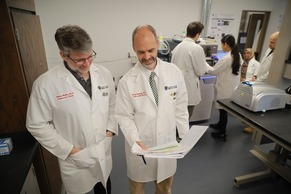 Staying Up to Date on New HABs Information!
This bulletin is being sent to local public health officers, Tribal health directors, subscribers to the HAB list, and key DPH staff.
The Harmful Algal Blooms (HABs) season has begun. One way to keep our state safe from the dangers of harmful cyanobacteria is to stay updated on current news existing in the HABs world. This newsletter highlights new biospecimen testing, asthma research and social media outreach that has been taking place across the country and in Wisconsin.
What’s new?
Algal Toxin ACE (Affinity Capture and Extraction)
Gold Standard Diagnostics Horsham, Inc. recently came out with a new test to identify algal toxins in biological samples. The test is called ABRAXIS ACE (Affinity Capture & Extraction)- Microcystins Kit and can capture and extract microcystin and nodularin toxins from both blood and urine samples. The test uses technology from magnetic beads to bind the ADDA region of the toxin resulting in a high sensitivity capture with minimal carryover of other matrix components.
This test is the first of its kind to identify algal toxins within human samples. Although the test is only available for use at the research level, it provides promising implications for future clinical use by doctors and veterinarians and will hopefully help both clinicians and public health professionals better understand and classify HAB-related illnesses.
Algae, aerosols and asthma
HABs not only cause illness through ingestion and skin contact, but through inhalation as well. Aerosolized cyanotoxins are generated through both natural mechanisms and human activity. Natural wave motions, jet skiing and boating through blooms are all examples of how cyanotoxins can become aerosolized. Inhalation of these cyanotoxins can create negative health effects. Unlike skin contact and ingestion, the inhalation exposure route is not well studied.

Research at the University of Toledo College of Medicine and Life Sciences recently found new evidence that airway exposure to the algal toxin microcystin creates an inflammatory response in lungs that is exacerbated in experimental models of asthma.
Dr. Steven Haller and David Kennedy, the researchers behind this study (pictured on the right), wanted to address the gap that exists in the literature regarding asthma and algal toxins.In the experiment, human lung airway cells were extracted via biopsy from people with asthma and people without asthma and exposed to aerosolized microcystin. The cells were exposed for three minutes each day every three days. Researchers were not expecting to find anything until they started testing longer exposures. However, Kennedy stated “Even after that short exposure in healthy cells, we saw a really significant response. That was one of the most eye-opening findings.” The response to the toxins in normal cells produced similar genes and behaviors as an asthmatic response. Likewise, the cells from people with asthma saw an exacerbated inflammatory response. These findings suggest that patients with asthma may be at a greater risk for health complications when exposed to aerosolized cyanotoxins.
By using actual human cells and real-world aerosol exposure, these findings are the first of its kind. This work has sparked further investigation and collaboration on how the aerosolization of toxins produces negative health effects. Next steps for these researchers include harnessing toxins directly off Lake Erie with an air sampling station to further investigate toxin health effects.
|

Let's Get Social
This issue's suggested post and photo:
|
It’s summertime in Wisconsin! You might be eager to throw on your swimsuit and dive straight into the lake, but it’s important to look before you leap to protect yourself against blue-green algae. Avoid swimming in water that looks like spilled green paint or pea soup, is discolored or streaky, or has mats floating on top. Learn more: https://www.dhs.wisconsin.gov/water/bg-algae/index.htm.

Stay in Touch

Missed a past issue? Previous issues are available on our Resources for Health Professionals webpage.
Email us your burning questions! If others can benefit from hearing the answer to your question, we’ll feature it in a future issue.
Remember that we are always available for consultation on any HAB health-related issue by email or phone (608-266-1120).
|
|